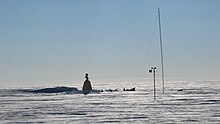
The North Pole, also known as the Geographic North Pole or Terrestrial North Pole, is the point in the Northern Hemisphere where the Earth's axis of rotation meets its surface. It is called the True North Pole to distinguish from the Magnetic North Pole.
Fiona Thornewill is an English explorer who reached the South Pole solo and unaided in a record 42 days in 2004, walking and skiing over 700 miles in the process.

In geography, a pole of inaccessibility is the farthest location in a given landmass, sea, or other topographical feature, starting from a given boundary, relative to a given criterion. A geographical criterion of inaccessibility marks a location that is the most challenging to reach according to that criterion. Often it refers to the most distant point from the coastline, implying the farthest point into a landmass from the shore, or the farthest point into a body of water from the shore. In these cases, a pole of inaccessibility is the center of a maximally large circle that can be drawn within an area of interest only touching but not crossing a coastline. Where a coast is imprecisely defined, the pole will be similarly imprecise.
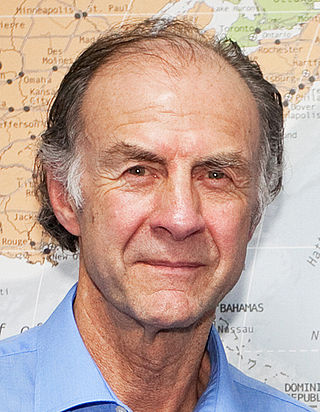
Sir Ranulph Twisleton-Wykeham-Fiennes, 3rd Baronet, commonly known as Sir Ranulph Fiennes and sometimes as Ran Fiennes, is a British explorer, writer and poet, who holds several endurance records.
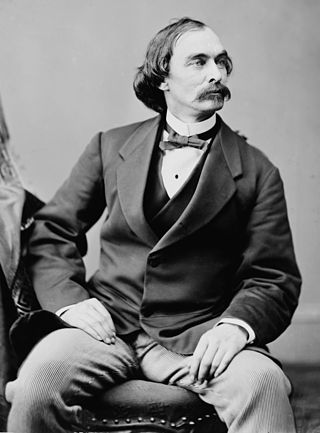
Isaac Israel Hayes was an American Arctic explorer, physician, and politician, who was appointed as the commanding officer at Satterlee General Hospital during the American Civil War, and was then elected, after the war, to the New York State Assembly.

Snowkiting or kite skiing is an outdoor winter sport where people use kite power to glide on snow or ice. The skier uses a kite to give them power over large jumps. The sport is similar to water-based kiteboarding, but with the footwear used in snowboarding or skiing. The principles of using the kite are the same, but in different terrain. In the early days of snowkiting, foil kites were the most common type; nowadays many kiteboarders use inflatable kites. However, since 2013, newly developed racing foil kites seem to dominate speed races and expedition races, like Red Bull Ragnarok and the Vake mini-expedition race. Snowkiting differs from other alpine sports in that it is possible for the snowkiter to travel uphill and downhill with any wind direction. Like kiteboarding, snowkiting can be very hazardous and should be learned and practiced with care. Snowkiting has become more popular in places often associated with skiing and snowboarding, such as Russia, Canada, Iceland, France, Switzerland, Austria, Norway, Sweden, Finland and the Northern and Central United States. The sport has become more diverse as adventurers use kites to travel great distances and sports enthusiasts push the boundaries of freestyle, big air, speed and back country exploration.

Antarctic Journal is a 2005 South Korea survival psychological horror film. It is the feature film debut by director Yim Pil-sung. The film mixes elements of psychological thriller and classical horror films while showing the hardships met by a modern Korean antarctic expedition trying to reach the pole of inaccessibility. The film generated some buzz before its release due to its large budget and notable cast, but wasn't a box office hit.
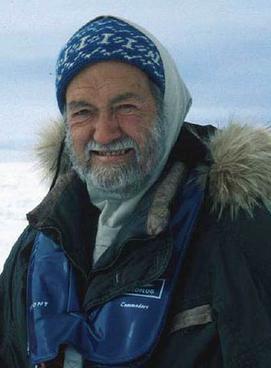
Sir Walter William Herbert was a British polar explorer, writer and artist. In 1969 he became the first man fully recognized for walking to the North Pole, on the 60th anniversary of Robert Peary's disputed expedition. He was described by Sir Ranulph Fiennes as "the greatest polar explorer of our time".

The Pole of Inaccessibility research station is a defunct Soviet research station in Kemp Land, Antarctica, at the southern pole of inaccessibility as defined in 1958 when the station was established. Later definitions give other locations, all relatively near this point. It performed meteorological observations from 14 to 26 December 1958. The Pole of Inaccessibility has the world's coldest year-round average temperature of −58.2 °C (−72.8 °F).
Paul Landry M.B. is a French-Canadian polar explorer, author, and adventurer who is the only paid man to ever reach three Geographical poles in a single year.

Robert Charles Swan, OBE, FRGS is the first person to walk to both poles.
The Polar Challenge was a competitive, 350 nautical mile team race taking place in the Arctic, to the 1996 location of the Magnetic North Pole. The race ran between mid-April and mid-May each year, taking teams approximately 4 weeks to complete, including the training time. This event should not be confused with the Polar Race, which was a different event taking a different route, and run by a different organisation.
Benjamin John Saunders is an English polar explorer, endurance athlete, and motivational speaker. He led the first return journey to the South Pole on foot via Shackleton and Scott's route in 2013–14, and skied solo to the North Pole in 2004. Saunders has skied more than 3,700 miles (6,000 km) on polar expeditions since 2001. He holds the record for the longest human-powered polar journey in history (2,888 km) and for the longest solo Arctic journey by a Briton (1,032 km).
Rupert Nigel Pendrill Hadow, known as Pen Hadow, is a British Arctic region explorer, advocate, adventurer and guide. He is the only person to have trekked solo, and without resupply by third parties, from Canada to the Geographic North Pole. He is also the first Briton to have trekked, without resupply by third parties, to both the North and South Geographic Poles from the respective continental coastlines of North America and Antarctica. Hadow also led the Catlin Arctic Survey (2007-2012) which investigated sea ice volume, ocean acidification and ocean circulation.

The South Pole, also known as the Geographic South Pole or Terrestrial South Pole, is the point in the Southern Hemisphere where the Earth's axis of rotation meets its surface. It is called the True South Pole to distinguish from the Magnetic South Pole.

Tom Avery, FRGS is a British explorer, author and motivational speaker. He made record-breaking journeys to the South Pole in 2002 and to the North Pole in 2005. He is one of fewer than ten people throughout history to have completed the Polar Trilogy; full length expeditions to the South Pole and North Pole and a coast to coast crossing of Greenland. Avery and his teammates hold two Guinness World Records; the fastest surface journey to the North Pole and the fastest coast-to-coast crossing of Greenland. He is also the youngest Briton to have reached both the North and South Poles on foot.

Lawrence Edward Grace "Titus" Oates was a British army officer, and later an Antarctic explorer, who died from hypothermia during the Terra Nova Expedition when he walked from his tent into a blizzard. His death, which occurred on his 32nd birthday, is seen as an act of self-sacrifice when, aware that the gangrene and frostbite from which he was suffering was compromising his three companions' chances of survival, he chose certain death for himself to relieve them of the burden of caring for him.
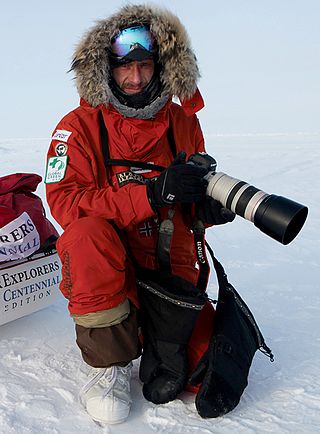
Sebastian Copeland is a British-American-French photographer, polar explorer, author, lecturer, and environmental advocate. He has led numerous expeditions in the polar regions to photograph and film endangered environments. In 2017, Copeland was named one of the world's top 25 adventurers of the last 25 years by Men's Journal. He is a fellow of The Explorers Club. His documentary Into the Cold was a featured selection at the 2010 Tribeca Film Festival and was released on DVD timed to Earth Day 2011.

